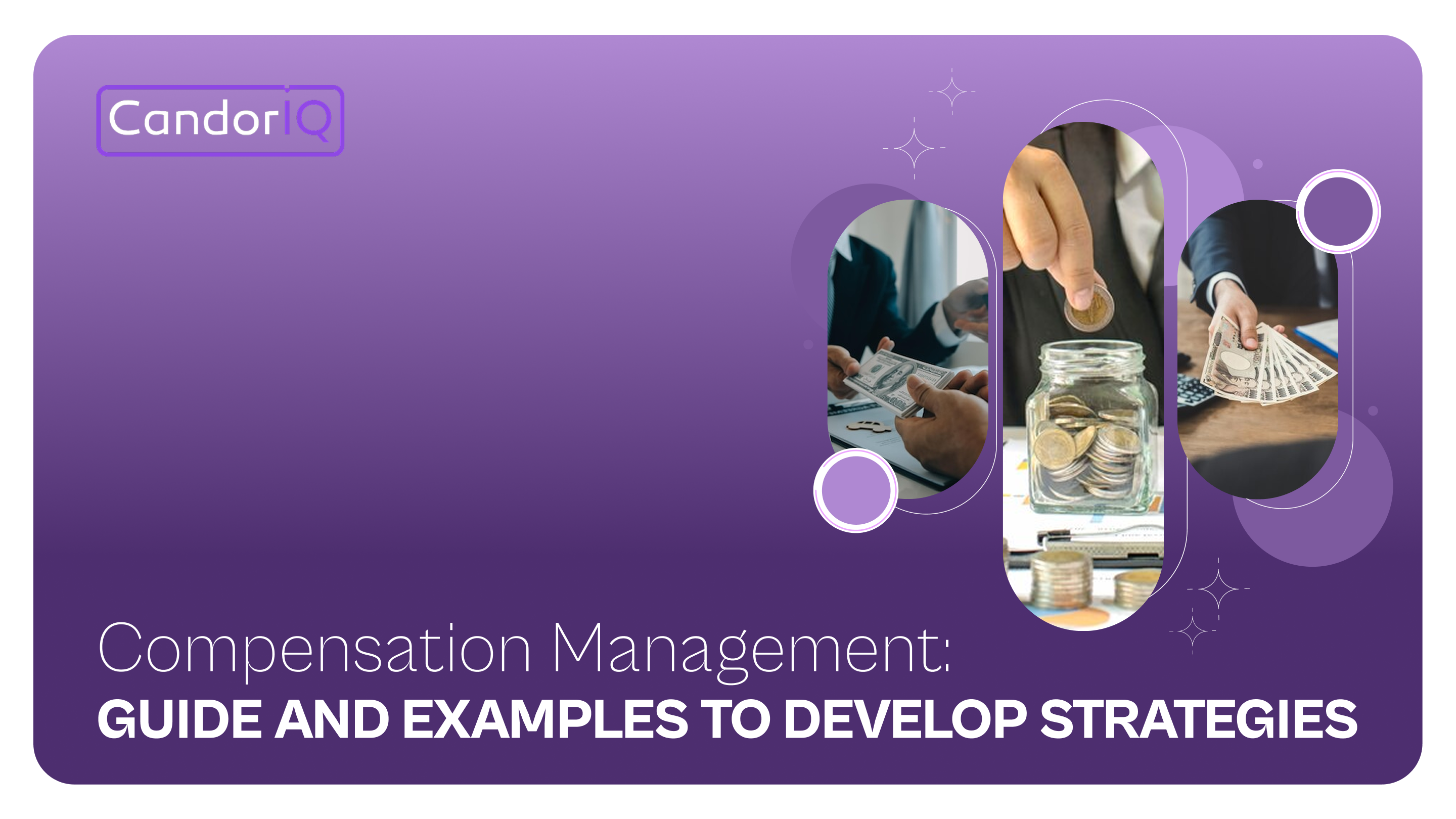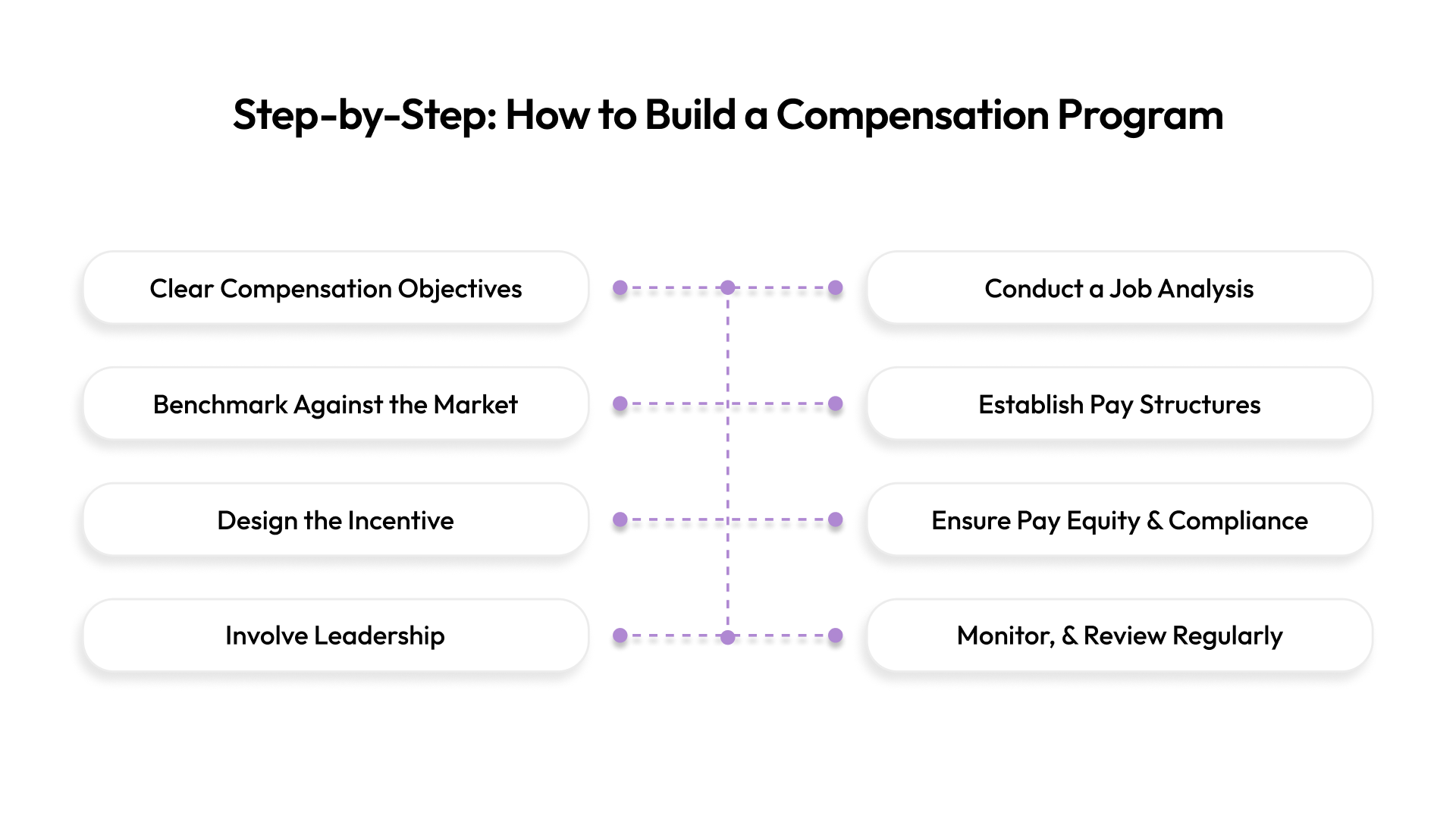Compensation Management: Guide and Examples to Develop Strategies
Master compensation strategies with examples. Discover key components, salary structures, and customized benefit plans. Gain insights and improve your approach now!

A clear compensation strategy does more than decide employees’ pay; it shapes how they feel valued at work. It affects morale, performance, and retention. If pay isn’t transparent or doesn’t meet expectations, trust can drop, and turnover can rise. In fact, the PayScale 2025 Fair Pay Impact Report shows that employees who feel underpaid are 45% more likely to seek a new job.
This highlights the importance of managing compensation with intent, accuracy, and fairness. Businesses today are moving beyond basic salary structures and adopting analytical pay models that reflect skills, performance, and market benchmarks. A strong compensation management system not only ensures pay equity but also strengthens employer branding and helps attract top talent.
In this blog, we’ll break down what effective compensation management looks like, share real-world examples, and discuss practical strategies to build a system that balances organizational goals with employee satisfaction.
Key Takeaways
- Compensation is more than just salary. A strong program blends base pay, bonuses, equity, and benefits to reward performance and strengthen employee loyalty.
- Understanding your market is crucial. Benchmarking and clear pay bands help keep pay competitive and consistent across teams.
- Fairness matters. Ensuring pay equity builds trust and boosts retention. Tools like CandorIQ make it easier to spot gaps and stay compliant.
- Collaboration fuels success. HR, finance, and leadership need to work together to design, communicate, and execute compensation plans effectively.
- Regularly review and refine your program to stay aligned with business goals and adapt to changing market conditions.
What Is Compensation Management?
Compensation management refers to the structured process of planning, implementing, and maintaining a company’s pay and rewards system. It ensures employees are compensated fairly for their work while keeping costs aligned with business goals. This includes everything from setting base salaries and variable pay to offering benefits, bonuses, equity, and non-monetary perks.
At its core, compensation management is about finding the right balance between rewarding performance and retaining top talent. It requires coordination between HR, finance, and leadership teams to define pay structures that attract skilled professionals and sustain long-term growth.
Unlike payroll, which focuses on the transactional aspect of paying employees, compensation management deals with the strategic side of pay. It defines how salaries are determined, how pay scales evolve, and how incentives drive productivity. It also shapes how employees perceive fairness, recognition, and opportunity within the organization.
A well-managed compensation program typically involves:
- Market Benchmarking: Reviewing industry and location-based salary data to stay competitive.
- Pay Structure Design: Defining pay bands, levels, and progression paths.
- Variable Pay and Incentives: Linking rewards to individual or team performance.
- Benefits and Recognition Programs: Adding non-cash rewards that improve job satisfaction.
- Compliance and Governance: Ensuring all pay practices meet labor laws and internal policies.
Effective compensation management not only addresses pay but also builds trust, improves engagement, and supports workforce planning. When done well, it helps companies attract, retain, and motivate employees while ensuring every dollar spent contributes to measurable business value.
Understanding what compensation management is provides the foundation, but building an effective program requires knowing its core components and how each element contributes to fair and strategic pay.
.png)
Suggested read: Creating an Effective Employee Compensation Plan
Core Components of a Modern Compensation Program

An effective compensation program is built on structure, clarity, and alignment with business and employee needs. It goes beyond fixed pay and incorporates multiple components that together define how value is recognized and rewarded.
1. Base Pay
Base pay is the foundation of every compensation plan. It refers to the fixed salary or hourly wage an employee receives in exchange for their work. Setting base pay involves evaluating job roles, market benchmarks, experience levels, and geographic location. Companies that maintain clear pay ranges for each role promote transparency and consistency across teams.
2. Variable Pay
Variable pay rewards employees based on their performance or the company’s financial success. It includes commissions, performance bonuses, profit-sharing, and incentives tied to measurable outcomes. This component encourages accountability and motivates employees to meet or exceed their goals.
3. Equity and Stock Options
Equity-based compensation allows employees to share in the company’s growth. Stock options or restricted stock units (RSUs) are common in startups and high-growth businesses, helping attract and retain skilled professionals who want long-term value. Offering equity also aligns employee interests with the company’s overall success.
4. Benefits and Perks
Benefits go beyond salary and often play a big role in an employee’s decision to stay. Health insurance, paid time off, retirement contributions, flexible working options, and mental health programs all contribute to employee satisfaction. Modern organizations also introduce lifestyle perks such as learning stipends or wellness budgets to create a supportive workplace.
5. Pay Equity and Compliance
Every compensation program must ensure fairness across gender, role, and geography. Regular audits, salary reviews, and transparent pay frameworks help prevent bias and maintain compliance with labor laws.
CandorIQ makes this easier. It spots pay gaps quickly, tracks equity trends, and automates compliance reporting. HR teams save time, reduce mistakes, and make fair, data-backed compensation decisions that build trust and support retention.
6. Performance and Review Cycles
Performance reviews connect employee achievements to compensation adjustments. Structured evaluation cycles help leaders make fair decisions on raises, promotions, or bonuses. Clear communication about how performance translates into pay fosters motivation and accountability.
7. Budget and Forecasting
Compensation planning must align with financial forecasts. HR and finance teams work together to track costs, model different pay scenarios, and ensure sustainability. A well-planned budget allows companies to stay competitive while managing payroll costs responsibly.
Together, these components form a cohesive system that rewards contribution, promotes transparency, and aligns workforce goals with business performance. A modern compensation program is not static; it evolves with company growth, market shifts, and employee expectations.
With a clear understanding of the core components that make up a modern compensation program, the next step is to explore the different compensation strategies and see how they can be applied effectively.
Compensation Strategy Types & Examples

Developing an effective compensation strategy isn’t about following a fixed formula; it’s about finding what fits your organization’s goals, workforce dynamics, and market position. Below are the key types of compensation management examples and strategies companies often adopt, along with how each can shape a sustainable pay structure.
1. Market-Based Compensation Strategy
This strategy focuses on staying competitive by benchmarking pay against similar roles across the industry. It ensures that salaries reflect current market realities and helps attract top talent.
- Uses compensation surveys and salary data to define pay ranges
- Regularly updates ranges to match market shifts
- Balances internal fairness with external competitiveness
When to use:
If your goal is to attract and retain skilled professionals in a competitive industry, a market-based model can be the foundation of your compensation plan. It also works well when transparency and fairness are key to employer branding.
2. Performance-Based Compensation Strategy
This approach rewards employees based on measurable results or contribution levels. It links pay directly to productivity and outcomes, encouraging high performance.
- Includes bonuses, commissions, or merit raises
- Relies on clear performance metrics and periodic reviews
- Motivates employees to meet and exceed goals
When to use:
Ideal for organizations where output can be tracked clearly, such as sales, marketing, or project-based roles. To make this model effective, ensure that performance goals are realistic and consistently evaluated.
3. Skill-Based Compensation Strategy
Here, pay depends on the range and depth of skills an employee possesses rather than just their job title. This encourages learning and continuous development.
- Rewards employees for acquiring new competencies
- Promotes flexibility in workforce deployment
- Reduces skill gaps across departments
When to use:
This approach suits companies that value cross-functional expertise, such as manufacturing, IT, or engineering firms. It is especially effective when you want to nurture internal talent and reduce dependency on external hiring.
4. Seniority-Based Compensation Strategy
This traditional model ties compensation increases to tenure and loyalty. It is often used in organizations that value long-term commitment.
- Builds trust and stability in the workforce
- Reduces turnover by recognizing long service
- May include annual increments or milestone bonuses
When to use:
If retaining experienced employees is a key business goal, a seniority-based structure can help. However, it is best combined with performance elements to prevent stagnation and maintain motivation.
5. Equity-Based Compensation Strategy
This strategy gives employees a stake in the company’s success by offering ownership-based rewards. It aligns employee interests with long-term business growth.
- Common forms include stock options, restricted stock units (RSUs), or profit-sharing plans
- Encourages employees to think like owners
- Builds loyalty and retention in fast-growing or startup environments
When to use:
Equity-based compensation works best for startups or high-growth firms where future value creation outweighs immediate cash rewards. It also strengthens the link between company performance and employee commitment.
6. Hybrid Compensation Strategy
Many companies blend multiple approaches to suit different roles and departments. For instance, sales teams may follow a performance-linked model, while R&D teams receive skill-based incentives.
- Offers flexibility to balance fairness and motivation
- Allows customization by department or seniority level
- Reduces risk of over-reliance on one pay approach
When to use:
If your organization spans diverse roles or geographies, a hybrid model ensures consistency without limiting adaptability. It is particularly effective for mid- to large-sized enterprises with varied workforce needs.
Selecting the right compensation strategy starts with understanding what drives your workforce, whether it is market competitiveness, performance, skill growth, or long-term loyalty. The most effective programs often combine elements of multiple strategies to support both organizational goals and employee satisfaction.
Knowing the types of compensation strategies is essential, but turning them into an effective program requires clear steps and careful planning.

Also Read: Effective Compensation Benchmarking for HR Teams in 2025
Step-by-Step: How to Build a Compensation Program

Building a structured compensation program requires clarity, reliable data, and a strong link between pay and performance. Each step should move the organization closer to fair, transparent, and goal-aligned compensation practices. This approach helps CPOs, CFOs/FP&A leaders, HRBPs, and Recruiting Managers work together effectively to design and implement a program that supports both business goals and employee satisfaction.
Step 1: Define Clear Compensation Objectives
Begin by setting the purpose of your compensation program. Identify whether the goal is to attract skilled talent, retain top performers, or maintain pay fairness across teams. Once the objective is clear, align it with your company’s mission and measurable outcomes, such as reduced turnover or improved satisfaction. Defining priorities early helps avoid inconsistent decisions later.
Step 2: Conduct a Job Analysis and Evaluation
Next, analyze every role in detail. Define its key responsibilities, required skills, and expected results. Evaluating each position based on its impact and complexity creates an internal structure for fair comparisons. Use consistent methods across departments to ensure that similar roles are treated equally and that each position’s value is clearly understood.
Step 3: Benchmark Against the Market
Compare your internal compensation data with current market trends. External benchmarking shows whether your pay structure is competitive or needs adjustment. Use credible salary surveys or industry data to identify where you stand. Review this information regularly to stay current, especially in fast-changing sectors like SaaS, fintech, and e-commerce.
Step 4: Establish Pay Structures and Salary Bands
Once you have market insights, organize positions into salary bands based on seniority, skill, and contribution. Define a clear structure that shows the progression path within each role. A transparent pay band system helps employees understand how their growth connects to pay advancement and ensures internal consistency across teams.
Step 5: Design the Incentive and Benefits Framework
After setting base salaries, structure the variable and non-cash components. Design performance-linked rewards that encourage achievement and balance them with meaningful benefits such as healthcare, flexibility, or learning allowances. When employees understand how their effort translates into tangible rewards, it builds stronger motivation and trust.
Step 6: Ensure Pay Equity and Compliance
Every organization must address fairness from the start. Conduct pay audits to identify and correct gaps based on gender, tenure, or role. Stay aligned with local pay transparency laws and keep clear documentation for accountability. Pay equity should not be an annual checkbox but a consistent part of compensation reviews.
Step 7: Involve Leadership and Communicate Internally
A successful compensation program depends on collaboration between leadership, HR, and finance teams. Once the structure is finalized, communicate it across the organization with clarity and confidence. Managers should be equipped to explain how pay decisions are made and what drives variations. This transparency helps build credibility and engagement.
Step 8: Implement, Monitor, and Review Regularly
After implementing your program, track its performance closely. Monitor key indicators such as pay gaps, retention, and employee satisfaction. CandorIQ provides dashboards for real-time monitoring, scenario modeling, and forecasting. This helps HR and finance teams adjust compensation strategies proactively, save time, reduce errors, and make informed decisions.
Regular reviews ensure your program evolves with workforce changes and market conditions. A well-executed compensation program not only aligns with business goals but also builds employee trust, loyalty, and engagement.
Conclusion
A well-structured compensation program goes beyond salaries. It integrates base pay, variable rewards, equity, benefits, pay equity, performance cycles, and financial planning to create a system that is fair, transparent, and aligned with business goals. By following a clear, step-by-step approach, organizations can ensure their compensation practices attract and retain talent, motivate employees, and support long-term growth.
Platforms like CandorIQ make these efforts more precise and actionable. It consolidates multiple tools into a single platform for managing pay bands, compensation cycles, headcount forecasting, and offer workflows. This unified approach eliminates fragmented processes, giving HR and finance teams a single source of truth for strategic compensation and workforce planning.
Want to simplify compensation management, reduce errors, and make fair, data-backed pay decisions faster? Book a demo with CandorIQ today and see how your HR team can save time, improve accuracy, and boost employee trust.
FAQs
1. How often should a company review its compensation program?
Compensation programs should be reviewed at least annually, but fast-growing companies or those in competitive industries may benefit from quarterly reviews to stay aligned with market trends and internal pay equity.
2. Can small HR teams manage complex compensation programs effectively?
Yes. Tools like CandorIQ help small HR teams automate workflows, track pay equity, and forecast budgets, allowing even lean teams to manage compensation with precision and efficiency.
3. What role does employee feedback play in compensation planning?
Employee feedback helps identify gaps in perception versus reality. Understanding how employees view fairness, benefits, and incentives can guide adjustments to improve satisfaction and retention.
4. How can companies ensure pay equity across global locations?
Global pay equity requires combining local market benchmarks with internal pay structures. Platforms like CandorIQ provide geo-adjusted insights and analytics to maintain fairness across regions.
5. What metrics are most important for evaluating a compensation program’s success?
Key metrics include turnover rates, employee satisfaction scores, pay equity gaps, promotion consistency, and budget adherence. Monitoring these indicators ensures the program meets business goals and supports workforce engagement.


